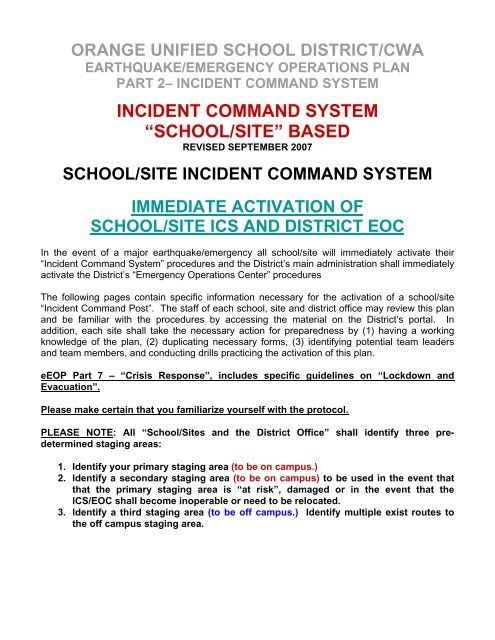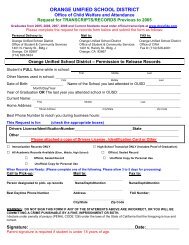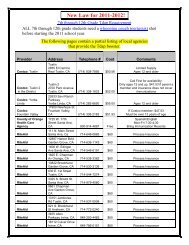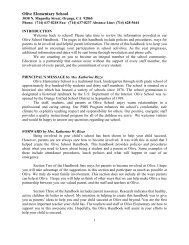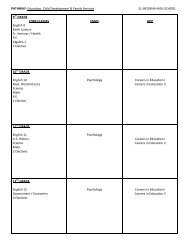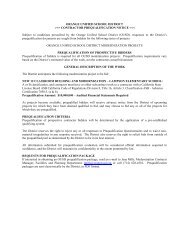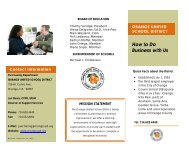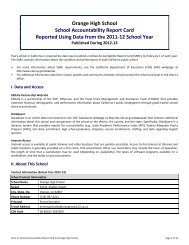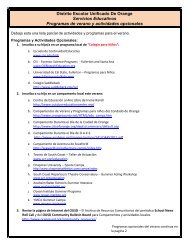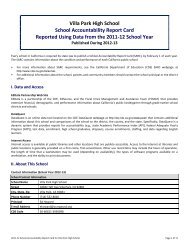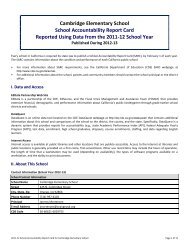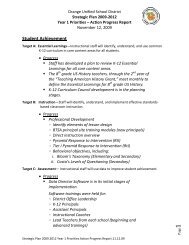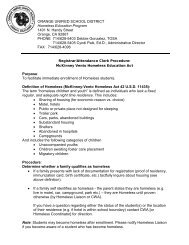incident command system âschool/siteâ based - Orange Unified ...
incident command system âschool/siteâ based - Orange Unified ...
incident command system âschool/siteâ based - Orange Unified ...
Create successful ePaper yourself
Turn your PDF publications into a flip-book with our unique Google optimized e-Paper software.
ORANGE UNIFIED SCHOOL DISTRICT/CWA<br />
EARTHQUAKE/EMERGENCY OPERATIONS PLAN<br />
PART 2– INCIDENT COMMAND SYSTEM<br />
INCIDENT COMMAND SYSTEM<br />
“SCHOOL/SITE” BASED<br />
REVISED SEPTEMBER 2007<br />
SCHOOL/SITE INCIDENT COMMAND SYSTEM<br />
IMMEDIATE ACTIVATION OF<br />
SCHOOL/SITE ICS AND DISTRICT EOC<br />
In the event of a major earthquake/emergency all school/site will immediately activate their<br />
“Incident Command System” procedures and the District’s main administration shall immediately<br />
activate the District’s “Emergency Operations Center” procedures<br />
The following pages contain specific information necessary for the activation of a school/site<br />
“Incident Command Post”. The staff of each school, site and district office may review this plan<br />
and be familiar with the procedures by accessing the material on the District’s portal. In<br />
addition, each site shall take the necessary action for preparedness by (1) having a working<br />
knowledge of the plan, (2) duplicating necessary forms, (3) identifying potential team leaders<br />
and team members, and conducting drills practicing the activation of this plan.<br />
eEOP Part 7 – “Crisis Response”, includes specific guidelines on “Lockdown and<br />
Evacuation”.<br />
Please make certain that you familiarize yourself with the protocol.<br />
PLEASE NOTE: All “School/Sites and the District Office” shall identify three predetermined<br />
staging areas:<br />
1. Identify your primary staging area (to be on campus.)<br />
2. Identify a secondary staging area (to be on campus) to be used in the event that<br />
that the primary staging area is “at risk”, damaged or in the event that the<br />
ICS/EOC shall become inoperable or need to be relocated.<br />
3. Identify a third staging area (to be off campus.) Identify multiple exist routes to<br />
the off campus staging area.
ORANGE UNIFIED SCHOOL DISTRICT/CWA<br />
EARTHQUAKE/EMERGENCY OPERATIONS PLAN<br />
PART 2– INCIDENT COMMAND SYSTEM<br />
TEAM ASSIGNMENTS: Each school/site shall have in place six Incident<br />
Command Post teams. The six teams are to have identified staff members and are to be<br />
prepared to implement the District’s “Earthquake Disaster Preparedness Plan”. The six teams<br />
are as follows:<br />
OUSD EARTHQUAKE DISASTER PREPAREDNESS PLAN<br />
SCHOOL SITE RESPONSE TEAMS<br />
COMMAND CENTER TEAM<br />
TEAM 1<br />
SEARCH & RESCUE<br />
TEAM 2<br />
SITE SECURITY<br />
TEAM 3<br />
SUPERVISION & ASSEMBLY<br />
TEAM 5<br />
STUDENT RELEASE<br />
TEAM 6<br />
FIRST AID<br />
TEAM 4<br />
The seventh team that will be discussed later in this section is the “Psychological Services Response<br />
Team”. This component is essential for all major emergencies. Include the “Psychological Services<br />
Response Team” in your school sites earthquake crisis disaster preparedness planning.<br />
PART 2 - EARTHQUAKE/EMERGENCY OPERATIONS PLAN/ INCIDENT COMMAND SYSTEM - PAGE 2
ORANGE UNIFIED SCHOOL DISTRICT/CWA<br />
EARTHQUAKE/EMERGENCY OPERATIONS PLAN<br />
PART 2– INCIDENT COMMAND SYSTEM<br />
COMMAND CENTER – TEAM 1<br />
CHECK LIST – INCIDENT COMMAND CENTER TEAM 1<br />
COMPLETED<br />
COMMAND CENTER - TEAM MEMBERS<br />
Incident Commander School/Site - Site Administrator (or designee per chain<br />
of <strong>command</strong>)<br />
1. Main Office - Secretary and Clerk(s)<br />
2. Teachers/Psychologist<br />
3. Students (Consider translation needs)<br />
COMPLETED<br />
COMPLETED<br />
COMMAND CENTER – EQUIPMENT AND SUPPLIES<br />
(Store in multiple locations as appropriate)<br />
Two-way radio (for long range communication)<br />
Battery operated AM/FM radio<br />
Bull horn or other portable loudspeaker <strong>system</strong><br />
Walkie-talkie for Team Leader<br />
Identification for Team Leader (orange vest and red baseball cap)<br />
Identification for all team members (orange vests)<br />
Emergency telephone numbers<br />
Incident Log forms (Xerox a large supply and place with disaster<br />
supplies)<br />
Pens/pencils, signs/posters (for making gate signs, etc.)<br />
Staff List<br />
Student Body List (alphabetical or by class period) and/or Emergency Cards<br />
3 x 5 cards (optional.)<br />
Flashlights<br />
Plot Plan - School Map<br />
Communications Script<br />
COMMAND CENTER – RESPONSIBILITIES & ACTIVITIES<br />
Receive warning signal from EOC and/or recognize sign(s) of <strong>incident</strong> such<br />
as earth tremor (earthquake), intense light and/or explosive sound (nuclear<br />
attack), etc.<br />
Alert school or site via appropriate warning signal.<br />
Report to predetermined meeting site for meeting with all teams.<br />
Locate/distribute equipment/supplies for Command Center team members.<br />
Determine team leader (principal or designee) and chain of <strong>command</strong>.<br />
PART 2 - EARTHQUAKE/EMERGENCY OPERATIONS PLAN/ INCIDENT COMMAND SYSTEM - PAGE 3
ORANGE UNIFIED SCHOOL DISTRICT/CWA<br />
EARTHQUAKE/EMERGENCY OPERATIONS PLAN<br />
PART 2– INCIDENT COMMAND SYSTEM<br />
Determine needed <strong>incident</strong>/disaster plan modification according to type of<br />
disaster.<br />
Determine need for alternative methods for communication/transportation<br />
such as bicycles, motorcycles, etc.<br />
Determine access needs for vehicles on campus.<br />
Assemble all other reporting teams at predetermined meeting site, issue<br />
equipment, and instruct teams to implement appropriate, assigned<br />
responsibilities. Important things to discuss with teams and/or Team Leaders<br />
are:<br />
A. Whether or not students are to remain in classrooms or move to<br />
Assembly Area. (Also which Assembly Area to be used.)<br />
B. Whether or not the site will be used for other school or<br />
community evacuees and locations for placing evacuees.<br />
C. Whether or not evacuation to another site is indicated.<br />
D. Location and/or method for handling media personnel.<br />
PLEASE NOTE: These discussion items may not be resolved until teams begin<br />
their assigned responsibilities and team leaders report findings to Command Center.<br />
Set up Incident Command Post near assembly area or alternative site.<br />
Establish Main Gate/Reunion Gate at the same or separate locations<br />
depending upon need.<br />
Establish a communications center and designate persons in charge.<br />
(Communications may be by phone, two-way radio, CB radio, walkie-talkie,<br />
messengers.)<br />
A. Set up the communications center in the office if phones are<br />
available or in the Assembly Area if no phone service. (If in the<br />
office, communication with Command Center at Assembly Area<br />
will be by walkie-talkie.)<br />
B. Designate two people for communications: one as<br />
Communications Officer who conducts internal and external<br />
communication under supervision of Command Center Team<br />
Leader; the other as Information Assistant who aids in releasing<br />
selected information about disaster victims.<br />
C. Instruct the Communications Officer and Information Assistant<br />
in correct use of Communications Script for making appropriate<br />
responses when talking by phone, or in person, to outsiders<br />
who are requesting information about the disaster and loved<br />
ones. ALL COMMUNICATIONS WITH MEDIA WILL BE<br />
THROUGH THE DISTRICT’S EOC PUBIC INFORMATIO<br />
OFFICER (PIO).<br />
D. Monitor all internal communication and approve all external<br />
communications, bulletins, and announcements to community,<br />
parents, and news media.<br />
PART 2 - EARTHQUAKE/EMERGENCY OPERATIONS PLAN/ INCIDENT COMMAND SYSTEM - PAGE 4
ORANGE UNIFIED SCHOOL DISTRICT/CWA<br />
EARTHQUAKE/EMERGENCY OPERATIONS PLAN<br />
PART 2– INCIDENT COMMAND SYSTEM<br />
E. Appoint person to monitor the Emergency Broadcast System on<br />
the battery operated radio) to keep abreast of external conditions<br />
and events that may affect the disaster site and local<br />
community, and for instructions in event of major disaster.<br />
Disseminate messages to other schools as directed by EOC.<br />
Be prepared to report when contacted by EOC about emergency needs,<br />
which may include evacuation or becoming an evacuation site. Important<br />
things to report:<br />
A. Condition of campus/site.<br />
B. Condition of staff and students.<br />
C. Immediate assistance, medical, psychological needs, supplies,<br />
food, etc., needed.<br />
D. Whether or not evacuation to another site is indicated.<br />
E. Whether or not the site will be used as an evacuation site for<br />
other school(s) or community members.<br />
F. How long school/site can hold out without assistance.<br />
G. Consequences, if no immediate help is sent.<br />
H. Neighborhood conditions.<br />
I. Advisability of closing school. (Students must remain under<br />
supervision at school and/or be reunited with parents/reliable<br />
adults.)<br />
Refer all major media to the District’s EOC Public Information Officer<br />
Monitor evacuation to the Assembly Area.<br />
A. In case of earthquake and the Intercom is not working, the<br />
teacher will authorize evacuation to the Assembly Area when<br />
the series of jolts has subsided and it appears safe to do so.<br />
B. If intercom is working, Command Center may announce when<br />
to move to Assembly Area.<br />
C. If damage is great, Search and Rescue may be dispatched to<br />
assist classrooms in the evacuation process.<br />
Account for all persons on the site according to Accountability Reports sent in<br />
by teachers from the Assembly Area and input from various Team Leaders.<br />
A. Use Staff List and Student Body List (master lists) for<br />
documenting persons who are missing or injured and update<br />
when found, released for medical care, etc.<br />
B. If desired, use 3 x 5 cards to maintain an alphabetized, quick<br />
reference of missing persons and update master lists when<br />
found.<br />
C. Maintain close contact with the Supervision Team and Student<br />
Release Team regarding the location and release of students<br />
and document on master lists.<br />
PART 2 - EARTHQUAKE/EMERGENCY OPERATIONS PLAN/ INCIDENT COMMAND SYSTEM - PAGE 5
ORANGE UNIFIED SCHOOL DISTRICT/CWA<br />
EARTHQUAKE/EMERGENCY OPERATIONS PLAN<br />
PART 2– INCIDENT COMMAND SYSTEM<br />
D. If documentation of student release is kept separately by the<br />
Student Release Team, maintain needed communications<br />
regarding the missing persons, students released to<br />
parents/adults, persons sent to medical care facilities, etc.<br />
Determine needs for medical assistance, urgent repairs, supplies,<br />
transportation, additional personnel, food, coffee, etc.<br />
Maintain constant contact with all Team Leaders and direct all disaster plan<br />
activities. (Done via walkie-talkie or runners from each team.)<br />
Communication between Team Leaders from Command Center, First Aid<br />
and Student Release Team will be essential in handling information and<br />
reuniting of families with injured (or dead) victims.<br />
Request Assembly Area Coordinator to assign students from Assembly Area<br />
to serve on any teams as may be needed.<br />
Communicate with EOC to report status of students and staff, school<br />
facilities, problems, and to obtain authority for major decisions.<br />
Be prepared to make decisions without EOC if a major disaster has rendered<br />
personnel and EOC site inoperable.<br />
Document all activities, events, actions, personnel, supplies used, and action<br />
taken throughout the <strong>incident</strong>/disaster. This is required by law. Make certain<br />
that you use or follow the format on the Incident/disaster Log Form<br />
PART 2 - EARTHQUAKE/EMERGENCY OPERATIONS PLAN/ INCIDENT COMMAND SYSTEM - PAGE 6
ORANGE UNIFIED SCHOOL DISTRICT/CWA<br />
EARTHQUAKE/EMERGENCY OPERATIONS PLAN<br />
PART 2– INCIDENT COMMAND SYSTEM<br />
COMPLETED<br />
SEARCH & RESCUE – TEAM 2<br />
CHECK LIST – SEARCH AND RESCUE TEAM 2<br />
SEARCH AND RESCUE - TEAM MEMBERS<br />
Teachers, Counselors, and/or Assistant Principal<br />
Custodian<br />
Maintenance personnel if on site<br />
Students as appropriate (In event of major <strong>incident</strong>, many personnel and<br />
students may be needed to provide immediate first aid until First Aid Team i<br />
summoned and help arrives).<br />
COMPLETED<br />
COMPLETED<br />
SEARCH AND RESCUE – EQUIPMENT AND SUPPLIES<br />
(Store in multiple locations as appropriate)<br />
Walkie-talkie for Team Leader (an all team members, if possible)<br />
Identification for Team Leader (orange vest and red baseball cap)<br />
Identification for all team members (orange vests)<br />
Master keys<br />
Fire extinguishers<br />
Emergency Tools.<br />
Map of school (worksite) designating all rooms and occupancy by personne<br />
students, use as storage, etc.<br />
Tag board and marking pen (for making emergency signs as needed.)<br />
SEARCH AND RESCUE – RESPONSIBILITIES & ACTIVITIES<br />
Interpret meaning of warning signal and/or recognize sign(s) of <strong>incident</strong><br />
such as earth tremors (earthquake), intense light and/or explosive sound<br />
(nuclear attack), etc.<br />
Report to predetermined meeting site for all teams.<br />
Locate/distribute equipment, supplies, and instructions for conducting assigned<br />
responsibilities.<br />
Confirm assignments with Command Center and maintain contact with team<br />
leader.<br />
Work in pairs and Search campus in a methodical pattern to find injured and/o<br />
missing persons. Pay particular attention to all restrooms, library, attendance<br />
areas, storage areas, locker rooms, classrooms, closets, etc.<br />
A. Explore each room visually, vocally, and physically and mark a<br />
appropriate to indicate that the area has been searched.<br />
B. Look, call out for replies, and actively search through rubble.<br />
C. Use available equipment to get to persons covered with debris.<br />
PART 2 - EARTHQUAKE/EMERGENCY OPERATIONS PLAN/ INCIDENT COMMAND SYSTEM - PAGE 7
ORANGE UNIFIED SCHOOL DISTRICT/CWA<br />
EARTHQUAKE/EMERGENCY OPERATIONS PLAN<br />
PART 2– INCIDENT COMMAND SYSTEM<br />
If possible, have one team member remain with any injured person while othe<br />
team member reports to Command Center or First Aid Station to summon firs<br />
aid as soon as possible. (Use of walkie-talkie will hasten this process).<br />
Assess damage to specific structures and report damage and/or usability to<br />
Command Center. Station team members as guards near unsafe buildings,<br />
indicated, to prevent re-entry until declared safe. If needed, ask Command<br />
Center to assign students as guards. Mark unsafe areas with signs. Direc<br />
loiterers to appropriate location.<br />
Maintain constant communication with Command Center.<br />
PART 2 - EARTHQUAKE/EMERGENCY OPERATIONS PLAN/ INCIDENT COMMAND SYSTEM - PAGE 8
ORANGE UNIFIED SCHOOL DISTRICT/CWA<br />
EARTHQUAKE/EMERGENCY OPERATIONS PLAN<br />
PART 2– INCIDENT COMMAND SYSTEM<br />
COMPLETED<br />
SITE SECURITY – TEAM 3<br />
CHECK LIST – SITE SECURITY TEAM 3<br />
SITE SECURITY - TEAM MEMBERS<br />
Teacher, Counselor, and/or Assistant Principals<br />
Custodian<br />
Maintenance Personnel, if on site<br />
Students<br />
COMPLETED<br />
COMPLETED<br />
SITE SECURITY – EQUIPMENT AND SUPPLIES<br />
(Store in multiple locations as appropriate)<br />
Walkie-talkie for Team Leader (and all team members if possible, especially<br />
on unsecured campus/site)<br />
Identification for Team Leader (orange vest and red baseball cap)<br />
Identification for all team members (orange vests)<br />
Master keys<br />
Appropriate pre-made signs (such as: Main Entrance, Parent Information<br />
Here, Media Report Here, Reunion Gate, etc.)<br />
Flashlights<br />
Fire extinguisher<br />
Sanitation supplies - Toilet paper, plastic bags for lining wastebaskets as<br />
emergency toilets, voting booths for toilet privacy, etc. Coordinate these with<br />
the First Aid Team<br />
Optional - emergency generator and fuel<br />
Valve keys-wrenches (for turning off utilities). Misc. tools for emergency<br />
repairs<br />
SITE SECURITY – RESPONSIBILITIES & ACTIVITIES<br />
Interpret meaning of warning signal and/or recognized sign(s) of <strong>incident</strong><br />
such as earth tremors (earthquake), intense light and/or explosive sound<br />
(nuclear attack, etc.)<br />
Report to predetermined meeting site for all teams.<br />
Locate & distribute equipment, supplies, and instructions for conducting<br />
assigned responsibilities.<br />
Confirm Team Leader assignment with Command Center and maintain<br />
contact.<br />
Work in pairs.<br />
Secure the school by locking all external gates, entrances, etc.(If locked<br />
campus/site) Assign team members to monitor main gate.<br />
PART 2 - EARTHQUAKE/EMERGENCY OPERATIONS PLAN/ INCIDENT COMMAND SYSTEM - PAGE 9
ORANGE UNIFIED SCHOOL DISTRICT/CWA<br />
EARTHQUAKE/EMERGENCY OPERATIONS PLAN<br />
PART 2– INCIDENT COMMAND SYSTEM<br />
-or-<br />
(If unsecured campus/site) Assign team members to patrol specific areas for<br />
controlling persons coming onto campus.<br />
A. Post appropriate signs.<br />
B. Direct fire, police, rescue, ambulance, etc., to area(s) of need.<br />
C. Refer media to District’s EOC Public Information Officer.<br />
D. Direct parents to Reunion Gate (if separate from Main Gate).<br />
E. Talk with Command Center via walkie-talkie (if available)<br />
regarding any problems.<br />
Check all utilities (water, gas, electricity) and turn off valves, if needed.<br />
Determine sanitation conditions and remedy when possible.<br />
Assist maintenance/operations personnel or utility company technicians, if<br />
needed, in emergency repair.<br />
Station team members as guards near unsafe buildings, if indicated, to<br />
prevent re-entry until declared safe. If needed, ask Command Center to<br />
assign students from the Support Team as guards.<br />
Operate an existing emergency generator, if needed.<br />
Communicate with the Command Center.<br />
PART 2 - EARTHQUAKE/EMERGENCY OPERATIONS PLAN/ INCIDENT COMMAND SYSTEM - PAGE 10
ORANGE UNIFIED SCHOOL DISTRICT/CWA<br />
EARTHQUAKE/EMERGENCY OPERATIONS PLAN<br />
PART 2– INCIDENT COMMAND SYSTEM<br />
COMPLETED<br />
FIRST AID – TEAM 4<br />
CHECK LIST – FIRST AID TEAM 4<br />
FIRST AID - TEAM MEMBERS<br />
School nurse<br />
Health clerk<br />
Other certificated and classified personnel<br />
Students as appropriate<br />
COMPLETED<br />
COMPLETED<br />
FIRST AID – EQUIPMENT AND SUPPLIES<br />
(Store in multiple locations as appropriate)<br />
Walkie-talkie for Team Leader<br />
Identification for Team Leader (orange vest and red baseball cap)<br />
Identification for all team members (orange vests)<br />
Any student medications<br />
First Aid supplies<br />
(Optional) Covering for outside first aid station.<br />
Refer to California Emergency First Aid Handbook (Hard Copy Plan)<br />
FIRST AID – RESPONSIBILITIES & ACTIVITIES<br />
Interpret meaning of warning signal and/or recognize sign(s) of <strong>incident</strong><br />
such as earth tremor (earthquake, explosive sound, gunshots, etc.) and<br />
respond appropriately.<br />
Report to predetermined meeting site and quickly verify the following<br />
predetermined assignments:<br />
A. Team members present and accounted for.<br />
B. Team members responsible for:<br />
• Initial mass casualty assessment/care.<br />
• Obtaining First Aid Station supplies.<br />
• First Aid Station set up (indoors if accessible/safe or<br />
outdoors as needed).<br />
• Human Relations Coordinator (family support for seriously<br />
injured/deceased loved ones).<br />
• Confirming all of the above with the Command Center.<br />
Conduct initial assessment and care for mass casualty victims.<br />
A. Work in pairs whenever possible and use Disaster/Crisis First<br />
Aid Kits.<br />
B. For persons using First Aid assessment skills:<br />
• Assess victims for urgent needs.<br />
PART 2 - EARTHQUAKE/EMERGENCY OPERATIONS PLAN/ INCIDENT COMMAND SYSTEM - PAGE 11
ORANGE UNIFIED SCHOOL DISTRICT/CWA<br />
EARTHQUAKE/EMERGENCY OPERATIONS PLAN<br />
PART 2– INCIDENT COMMAND SYSTEM<br />
• Care for bleeding, shock, breathing, etc., according to<br />
severity/number of victims.<br />
C. For persons using Triage assessment skills:<br />
• Access for mobility, breathing, circulation, and mental<br />
status.<br />
• Stabilize and tag according to assessment findings.<br />
D. According to the number of victims, hazardous surroundings,<br />
available personnel, etc., provide further care at <strong>incident</strong> site<br />
(supplies must be brought from First Aid Station) or after<br />
transport to First Aid Station.<br />
Obtain supplies and set up First Aid Station as soon as possible. Use<br />
"Layout Map" to assemble/organize supplies in the 9 first aid categories.<br />
Maintain communication with the Command Center.<br />
A. Status and needs of victims.<br />
B. Locations of victims still needing initial care.<br />
C. Available medical care, when it will be available, and location<br />
for student release via ambulance.<br />
D. Request for additional supplies and assistance.<br />
Conduct first aid for stabilization and maintenance efforts.<br />
A. Receive transported victims at First Aid Station for maximizing<br />
first aid care at one location.<br />
B. Provide care for wounds, shock, fractures, other first aid not<br />
rendered during initial response to mass casualties, emotional<br />
support, etc.<br />
Document first aid care and release of victims as follows:<br />
A. Document first aid for each victim using 3 x 5 cards, which are<br />
then tied around the victim's neck:<br />
• Name<br />
• Date<br />
• Injury<br />
• First Aid Given<br />
B. If victim is unable to talk or deceased, attach name tag for<br />
identification purposes.<br />
C. When released, remove 3 x 5 card from neck, record release<br />
time/destination, and retain card as permanent record.<br />
D. If to be released via ambulance, transport student to campus<br />
area designated for that purpose.<br />
E. Report released victims to Command Center.<br />
PART 2 - EARTHQUAKE/EMERGENCY OPERATIONS PLAN/ INCIDENT COMMAND SYSTEM - PAGE 12
ORANGE UNIFIED SCHOOL DISTRICT/CWA<br />
EARTHQUAKE/EMERGENCY OPERATIONS PLAN<br />
PART 2– INCIDENT COMMAND SYSTEM<br />
Provide for morgue care.<br />
A. Cover deceased with sheets until identified with a name tag.<br />
B. Document name/pertinent data on 3 x 5 card and maintain as<br />
permanent record at First Aid Station.<br />
C. Place in body bag (33 gallon plastic bag will suffice), seal,<br />
identify and transport when time permits to morgue location<br />
(indoor room, locked, away from the living and any food<br />
preparation areas.)<br />
D. Have Human Relations Coordinator available to assist grieving<br />
family members or friends who come to identify loved ones or<br />
learn of their death.<br />
Be prepared to cooperate with and provide care under direction of the<br />
following first aid/medical personnel who assist in disaster/crisis events.<br />
A. Red Cross first aid and nursing volunteers.<br />
B. Paramedics.<br />
C. Fire Medical Aid Division or other medical personnel.<br />
PART 2 - EARTHQUAKE/EMERGENCY OPERATIONS PLAN/ INCIDENT COMMAND SYSTEM - PAGE 13
ORANGE UNIFIED SCHOOL DISTRICT/CWA<br />
EARTHQUAKE/EMERGENCY OPERATIONS PLAN<br />
PART 2– INCIDENT COMMAND SYSTEM<br />
SUPERVISION & ASSEMBLY – TEAM 5<br />
CHECK LIST – SUPERVISION & ASSEMBLEY TEAM 5<br />
COMPLETED<br />
COMPLETED<br />
SUPERVISION & ASSEMBLY - TEAM MEMBERS<br />
Teachers and teacher assistants<br />
Students<br />
SUPERVISION & ASSEMBLY – EQUIPMENT AND SUPPLIES<br />
(Store in multiple locations as appropriate)<br />
Incident/Disaster Plan folder<br />
A. Emergency Procedures Check List<br />
B. Student Accountability Report forms (Xerox a large quantity<br />
for immediate use)<br />
C. Travel Route map<br />
D. Assembly Area Map<br />
Identification for Team Leader (orange vest and red baseball cap)<br />
Identification for all team members (orange vests)<br />
Crowd control ideas (group exercises, songs, teaching games, stress<br />
relievers, etc.)<br />
Attendance Folder (for all periods)<br />
Classroom first aid supplies:<br />
Supplies Amount How Used<br />
Storage Container............. 1 ..... Store first aid supplies<br />
(Backpack or other container for <strong>incident</strong> use.<br />
with contents in ziplock<br />
baggies)<br />
Gauze pads, non-sterile ......50 Cover wounds, apply<br />
(3 x 3 or 4 x 4) pressure for control of<br />
bleeding, and clean minor<br />
wounds.<br />
Roller Gauze, 4" wide......... 1 Secure gauze pads over<br />
wounds.<br />
Adhesive tape, 1" wide........ 1<br />
Secure gauze pads or<br />
bandages over wounds.<br />
Scissors....................<br />
1 pr Cut roller gauze<br />
Phisoderm in 4 oz. (approx.)... 1 Clean wounds.<br />
container<br />
PART 2 - EARTHQUAKE/EMERGENCY OPERATIONS PLAN/ INCIDENT COMMAND SYSTEM - PAGE 14
ORANGE UNIFIED SCHOOL DISTRICT/CWA<br />
EARTHQUAKE/EMERGENCY OPERATIONS PLAN<br />
PART 2– INCIDENT COMMAND SYSTEM<br />
Bandaids, Regular size, 1"x3" 20 Cover minor wounds.<br />
Bandaids, Large size, 2"x4". 10<br />
Latex Gloves.....<br />
Medium-20 Protection from blood & body<br />
fluids<br />
Large - 20<br />
For trained teachers only....10 of Label victims<br />
each color. Triage tags made<br />
of red and yellow laminated<br />
construction paper (4" x 5") with<br />
24" ties attached.<br />
Red = Immediate<br />
Yellow = Delayed<br />
Walkie-talkie for Team Leader<br />
Bull horn or other portable loudspeaker <strong>system</strong> (May be same one used by<br />
Command Center.)<br />
Keys (if any) to Assembly Area entrance<br />
Signs and stakes (Optional for Assembly Area markers)<br />
Incident Logs or equivalent<br />
Pencils/pens<br />
3 x 5 cards and file box for holding alphabetized cards of community<br />
evacuees<br />
COMPLETED<br />
SUPERVISION & ASSEMBLY<br />
RESPONSIBILITIES & ACTIVITIES<br />
Interpret meaning of warning signal and/or recognized sign(s) of <strong>incident</strong><br />
such as earth tremors (earthquake), intense light and/or explosive sound<br />
(nuclear attack), etc.<br />
Give appropriate <strong>command</strong>, “Duck, Cover, Hold” or “Evacuate.” (Staff<br />
members not with assigned students shall report to their predetermined<br />
location.)<br />
A. Determine injured persons and assist as appropriate.<br />
B. Determine need for cooperation with neighboring teacher (one<br />
teacher nay assist two classes of students if second teacher is<br />
injured or must remain with injured students until first aid<br />
arrives.)<br />
C. In case of earthquake and there are injured, immovable<br />
students and no other teacher to assist, surround injured<br />
student(s) with suitable furniture for protection from further<br />
PART 2 - EARTHQUAKE/EMERGENCY OPERATIONS PLAN/ INCIDENT COMMAND SYSTEM - PAGE 15
ORANGE UNIFIED SCHOOL DISTRICT/CWA<br />
EARTHQUAKE/EMERGENCY OPERATIONS PLAN<br />
PART 2– INCIDENT COMMAND SYSTEM<br />
earthquake action and take remaining students to Assembly<br />
Area. If teacher aide or volunteer is present, assign to remain<br />
with student(s) in classroom until help arrives.<br />
Evacuate to Assembly Area, as practiced, when given signal or deemed<br />
appropriate.<br />
Unlock/open any entrance to the Assembly Area.<br />
A. Plan for a main assembly area outdoors and alternative sites in<br />
case the main Assembly Area is not accessible or is in danger<br />
from possible hazards such as pending explosion, etc.<br />
B. Practice using alternate routes to Assembly Area by blocking<br />
routes during practice sessions.<br />
Assign team members to control entrances to Assembly Areas.<br />
Direct classes or students to Assembly Area stations (each team member<br />
must have Assembly Area map in hand).<br />
Locate/distribute equipment, supplies, and instructions for conducting<br />
assigned responsibilities at Assembly Area.<br />
Confirm Assembly Area Assignment with Command Center.<br />
Complete Student Accountability Reports and turn it in to Command Center .<br />
Role of Assembly Area Coordinator: Manage Assembly Area activities as<br />
follows:<br />
C. Assist in obtaining Student Accountability Reports from<br />
teachers for Command Center (located at Assembly Area).<br />
D. Assign students to assist in Assembly Area as needed.<br />
E. Assign students or staff to serve on other teams when<br />
requested by Command Center.<br />
F. Document important events to be acted upon and/or for future<br />
records, as needed. (Use Incident/Disaster Log forms or<br />
equivalent).<br />
G. Cooperate with Command Center Team and the Student<br />
Release Team in the location and release of students.<br />
2. Document on attendance folder when students are sent to reunion<br />
gate for release to parent/adult.<br />
3. Supervise and reassure students throughout duration of emergency<br />
using Crowd Control ideas to reduce stress and create an "espirit de<br />
corps."<br />
4. Use the same equipment, supplies, and responsibilities guidelines<br />
when evacuating with students to another school or site.<br />
PART 2 - EARTHQUAKE/EMERGENCY OPERATIONS PLAN/ INCIDENT COMMAND SYSTEM - PAGE 16
ORANGE UNIFIED SCHOOL DISTRICT/CWA<br />
EARTHQUAKE/EMERGENCY OPERATIONS PLAN<br />
PART 2– INCIDENT COMMAND SYSTEM<br />
COMPLETED<br />
STUDENT RELEASE – TEAM 6<br />
CHECK LIST – STUDENT RELEASE TEAM 6<br />
STUDENT RELEASE - TEAM MEMBERS<br />
Teacher (or Assistant Principal or Counselor)<br />
Clerk(s) (interpreter, if needed)<br />
Students<br />
COMPLETED<br />
STUDENT RELEASE – EQUIPMENT AND SUPPLIES<br />
(Store in multiple locations as appropriate)<br />
Walkie-talkie for Team Leader<br />
Walkie-talkie for other team members assigned to Main Gate and Reunion<br />
Gate (if separate from Main Gate)<br />
Identification for Team Leader (orange vest and red baseball cap)<br />
Identification for all team members (orange vests)<br />
Keys for any gate/door to Reunion Gate<br />
Assembly Area Maps, 1 per team member<br />
Student Body List (alphabetized or by class period) and/or Emergency Cards<br />
Pens and pencils<br />
Table to hold above materials.<br />
Incident Student Sign Out Sheets (Xerox a large supply and store with<br />
supplies.)<br />
COMPLETED<br />
STUDENT RELEASE – RESPONSIBILITIES & ACTIVITIES<br />
Interpret meaning of warning signal and/or recognized sign(s) of <strong>incident</strong>,<br />
such as earth tremor (earthquake), intense light and/or explosive sound<br />
(nuclear attack), etc..<br />
Report to predetermined meeting site.<br />
Locate/distribute equipment, supplies, and instructions for conducting<br />
assigned responsibilities.<br />
Confirm Team Leader assignment with Command Center.<br />
Work in pairs when possible.<br />
Set up Reunion Gate with Student Body List (and/or Emergency Cards) and<br />
related supplies on table.<br />
Communicate between teams as needed in the location and release of<br />
students.<br />
Assign team members to Main Gate and Reunion Gate (if separate locations)<br />
for receiving parent requests, sending messages, and locating students for<br />
release.<br />
PART 2 - EARTHQUAKE/EMERGENCY OPERATIONS PLAN/ INCIDENT COMMAND SYSTEM - PAGE 17
ORANGE UNIFIED SCHOOL DISTRICT/CWA<br />
EARTHQUAKE/EMERGENCY OPERATIONS PLAN<br />
PART 2– INCIDENT COMMAND SYSTEM<br />
Arrange for responsible First Aid Team member or designee to provide<br />
emotional support while informing family members about the condition of<br />
loved ones who are injured or dead.<br />
Process reuniting of students with parents/reliable adults:<br />
Please Note: When Main Gate and Reunion Gate are at separate locations,<br />
the documentation of student release may occur at the Main Gate, Reunion<br />
Gate or both. Advance planning is necessary to assure accountability.<br />
Receive parent/adult request for child at Main Gate or Reunion Gate. If<br />
gates are at separate locations, notify Reunion Gate of request and send<br />
parent to that location.<br />
If gates are at separate location: Main Gate may document student release<br />
noting time, name of adult and destination.<br />
Upon request, call for student from Assembly Area (or other known location)<br />
via walkie-talkie or student messenger.<br />
• Question student (not in the presence of the adult) to verify that<br />
this is an appropriate release. Verify the following:<br />
• Who is this person that has come to pick you up? (If parent,<br />
proceed with Step d).<br />
• Do parents know this person?<br />
• Where does this person live? Have you been there before?<br />
• Do you feel comfortable going with this person?<br />
• Do you think your parents would want you to go with this person?<br />
If adult is parent or verified as reliable, release child.<br />
If Main Gate is responsible for documenting release at time of parent request,<br />
Reunion Gate will only release students that have been called from Assembly Area<br />
per request of Main Gate.<br />
If student is not released, send student back to Assembly Area along with<br />
notification via walkie-talkie or messenger.<br />
If Main Gate is at separate area and responsible for release documentation, report<br />
all retained students to Main Gate for accounting purposes.<br />
Document releases on Sign Out Sheet.<br />
PART 2 - EARTHQUAKE/EMERGENCY OPERATIONS PLAN/ INCIDENT COMMAND SYSTEM - PAGE 18
ORANGE UNIFIED SCHOOL DISTRICT/CWA<br />
EARTHQUAKE/EMERGENCY OPERATIONS PLAN<br />
PART 2– INCIDENT COMMAND SYSTEM<br />
COMPLETED<br />
POST INCIDENT<br />
PSYCHOLOGICAL SERVICES<br />
CRISIS RESPONSE – TEAM 7<br />
CHECK LIST – SEARCH AND RESCUE TEAM 2<br />
CRISIS RESPONSE - TEAM MEMBERS<br />
School Psychologist<br />
School Counselors<br />
COMPLETED<br />
COMPLETED<br />
CRISIS RESPONSE – EQUIPMENT AND SUPPLIES<br />
(Store in multiple locations as appropriate)<br />
Identification Badges<br />
School Map<br />
School Staff List<br />
Psychological First Aid Packet<br />
• “Student Referral Checklist” for completion by teachers and staff<br />
• Crisis Referral Logs<br />
• Crisis Interview Form Cards<br />
• Counseling Agency Lists<br />
• Coping with Loss/Crisis Handouts<br />
CRISIS RESPONSE – RESPONSIBILITIES & ACTIVITIES<br />
Prior to initiating a crisis response, collect information from the Director of<br />
Pupil Personnel Services or the Coordinator of Psychology Services.<br />
Upon arrival at the school site, gather factual information and consult with<br />
principal regarding interventions needed. Consult as necessary with the onsite<br />
first aid team.<br />
Before disseminating information, review with principal what, how, and who<br />
will share information with staff, students, parents, neighboring schools and<br />
the community. Providing factual information controls rumors.<br />
To initiate the Crisis Referral Process, provide referral checklists to teacher<br />
and other school staff and maintain a Student Referral Log.<br />
Prior to beginning interventions, ascertain that all team members are fully<br />
informed and have been assigned confidential work space<br />
Identify high risk students by obtaining oral input and student referral<br />
checklists from school staff.<br />
Prioritize and assign interventions with students including individual<br />
interviews, classroom presentations, group counseling, and referral to<br />
PART 2 - EARTHQUAKE/EMERGENCY OPERATIONS PLAN/ INCIDENT COMMAND SYSTEM - PAGE 19
ORANGE UNIFIED SCHOOL DISTRICT/CWA<br />
EARTHQUAKE/EMERGENCY OPERATIONS PLAN<br />
PART 2– INCIDENT COMMAND SYSTEM<br />
community agencies.<br />
Consider interventions with parents including phone calls, parent meetings,<br />
and referrals to community agencies.<br />
Plan interventions with faculty including individual consultation and staff<br />
meetings in the morning and at school closure.<br />
At the end of each daily, debrief Psychological Services Crisis Team by<br />
reviewing process/status of referred students, prioritizing needs, planning<br />
follow up actions and providing support to team members.<br />
The following pages contain “Forms” to be used by the<br />
School/Site ICP Teams”. Please review the forms and<br />
duplicate as needed.<br />
PART 2 - EARTHQUAKE/EMERGENCY OPERATIONS PLAN/ INCIDENT COMMAND SYSTEM - PAGE 20
ORANGE UNIFIED SCHOOL DISTRICT/CWA<br />
EARTHQUAKE/EMERGENCY OPERATIONS PLAN<br />
PART 2– INCIDENT COMMAND SYSTEM<br />
Earthquake, Disaster Preparedness Plan<br />
One Page Overview of ICS Teams and Responsibilities<br />
Team Team Name Personnel General Responsibilities<br />
1 Command<br />
Center<br />
2 Search and<br />
Rescue<br />
Site administrators,<br />
secretaries, clerk,<br />
teachers, students<br />
Teacher (or assistant<br />
principals and/or counselors).<br />
custodian,<br />
when available,<br />
maintenance<br />
personnel if on site.<br />
3 Site Security Teachers, (or assistant<br />
principals, and/or<br />
counselors), custodian<br />
as soon as available,<br />
maintenance<br />
personnel, if on site.<br />
4 First Aid School nurse, health<br />
clerk, teachers.<br />
5 Supervision<br />
& Assembly<br />
6 Student<br />
Release<br />
Teachers or other<br />
staff members.<br />
1. Account for the presence of all students and staff.<br />
2. Implement and coordinate all disaster operations.<br />
3. Control internal and external communication.<br />
4. Maintain log and prepare reports for<br />
Superintendent and District's EOC.<br />
1. Search campus in a methodical pattern to find injured and<br />
missing persons.<br />
2. Report location of all injured persons to Command Center.<br />
3. Access damage to structures and report to Command<br />
Center.<br />
4. Station team members as guards near unsafe buildings to<br />
prevent re-entry.<br />
5. Direct loiterers to appropriate locations.<br />
1. Secure school/site by locking all external gates, doors, etc.<br />
2. Monitor Main Gate and any entrances.<br />
3. Route fire and rescue, ambulance, police.<br />
4. Escort media to Information Center.<br />
5. Check all utilities (water, gas, electricity).<br />
6. Determine sanitation conditions.<br />
7. Report conditions to Command Center.<br />
8. Assist on Search and rescue Team as needed.<br />
1. Administer first aid.<br />
2. Document name, injury, first aid given.<br />
3. Determine need for medical assistance.<br />
4. Work cooperatively with outside agencies.<br />
5. Keep Command Center informed.<br />
6. Maintain morgue as needed.<br />
1. Evacuate and direct class or students, when appropriate,<br />
using pre- determined routes to pre-planned station at<br />
Assembly Area.<br />
2. Assign someone as Assembly area Coordinator.<br />
3. Control entrances to assembly area.<br />
4. Manage all assembly area activities and communications.<br />
5. Account for students.<br />
6. Determine need for assisting neighboring teacher.<br />
7. Supervise and reassure student throughout duration of<br />
disaster.<br />
1. Staff main gate and reunion gate.<br />
2. Establish messenger <strong>system</strong> between Main Gate,<br />
Reunion Gate, and Assembly Area.<br />
3. Process the reuniting of students with parents,<br />
guardians and family members.<br />
4. Document the records of released students on the sign out<br />
sheet.<br />
PART 2 - EARTHQUAKE/EMERGENCY OPERATIONS PLAN/ INCIDENT COMMAND SYSTEM - PAGE 21
ORANGE UNIFIED SCHOOL DISTRICT/CWA<br />
EARTHQUAKE/EMERGENCY OPERATIONS PLAN<br />
PART 2– INCIDENT COMMAND SYSTEM<br />
EARTHQUAKE DISASTER PREPAREDNESS PLAN – ONE PAGE ICP TEAM ASSIGNMENTS<br />
No.<br />
1<br />
2<br />
3<br />
4<br />
5<br />
6<br />
7<br />
8<br />
9<br />
10<br />
11<br />
12<br />
13<br />
14<br />
15<br />
16<br />
17<br />
18<br />
19<br />
20<br />
21<br />
22<br />
23<br />
24<br />
25<br />
26<br />
27<br />
28<br />
29<br />
30<br />
31<br />
32<br />
33<br />
34<br />
35<br />
Name of Staff Member<br />
(Place an X in the box to mark<br />
ICP team assignment)<br />
#1<br />
Command<br />
Center<br />
#2<br />
Search &<br />
Rescue<br />
#3<br />
Site<br />
Security<br />
#4<br />
First<br />
Aid<br />
<strong>Orange</strong> <strong>Unified</strong> School District – Earthquake Disaster Preparedness Plan<br />
#5<br />
Supervise<br />
Assembly<br />
#6<br />
Student<br />
Release<br />
PART 2 - EARTHQUAKE/EMERGENCY OPERATIONS PLAN/ INCIDENT COMMAND SYSTEM - PAGE 22
ORANGE UNIFIED SCHOOL DISTRICT/CWA<br />
EARTHQUAKE/EMERGENCY OPERATIONS PLAN<br />
PART 2– INCIDENT COMMAND SYSTEM<br />
ICS - EARTHQUAKE DISASTER LOG<br />
Please make a chronological record of all pertinent information and events as they occur throughout this disaster.<br />
School: ___________________ Nature of disaster: __________________ Date: ___________ Page #: _______<br />
Time-AM/PM<br />
Information/description of activities/action taken/people<br />
involved/material used/re-location/comments, etc.<br />
Name of the<br />
recorder<br />
All pages in this log are to be returned to the school site’s EOC Command Center. If additional sheets are needed,<br />
please use notebook or Xerox paper and follow page format. There is a legal mandate to maintain an accurate log<br />
throughout an <strong>incident</strong>.<br />
PART 2 - EARTHQUAKE/EMERGENCY OPERATIONS PLAN/ INCIDENT COMMAND SYSTEM - PAGE 23
ORANGE UNIFIED SCHOOL DISTRICT/CWA<br />
EARTHQUAKE/EMERGENCY OPERATIONS PLAN<br />
PART 2– INCIDENT COMMAND SYSTEM<br />
ICS - STUDENT ACCOUNTABILITY REPORT<br />
Please complete the following. If a yes answer is reported, make certain that each student is identified.<br />
Name of Teacher: __________________<br />
Room # ___________ Date: ___________<br />
Are any students absent? No _______ Yes _______<br />
1. 5.<br />
2. 6.<br />
3. 7.<br />
4. 8.<br />
Are any students in your class injured? No _______ Yes _______<br />
1. 5.<br />
2. 6.<br />
3. 7.<br />
4. 8.<br />
Were any injured students left in the classroom? No _______ Yes _______<br />
Names:<br />
Location:<br />
1.<br />
2.<br />
3.<br />
4.<br />
Are any students missing? No _______ Yes _______<br />
1. Comments:<br />
2.<br />
3.<br />
4.<br />
There are additional comments on the back of this page? No _______ Yes _______<br />
PART 2 - EARTHQUAKE/EMERGENCY OPERATIONS PLAN/ INCIDENT COMMAND SYSTEM - PAGE 24
ORANGE UNIFIED SCHOOL DISTRICT/CWA<br />
EARTHQUAKE/EMERGENCY OPERATIONS PLAN<br />
PART 2– INCIDENT COMMAND SYSTEM<br />
STUDENT RELEASE TEAM – SIGN OUT SHEET<br />
Name of School: ____________________ Date of Incident: ____________<br />
Released by: ___________________<br />
Record the following for each student released. Do not release the student unless all of the information is complete.<br />
Student’s Name Destination - Include addresses, phone numbers, comments. Signature Time<br />
Please return this form to the Incident Command Center. If you run out of forms, use notebook paper & number each<br />
sheet.<br />
PART 2 - EARTHQUAKE/EMERGENCY OPERATIONS PLAN/ INCIDENT COMMAND SYSTEM - PAGE 25
ORANGE UNIFIED SCHOOL DISTRICT/CWA<br />
EARTHQUAKE/EMERGENCY OPERATIONS PLAN<br />
PART 2– INCIDENT COMMAND SYSTEM<br />
EARTHQUAKE/DISASTER ICS<br />
COMMUNICATIONS SCRIPT<br />
(To be used by Communications Officer at the School Site’s and District’s Command Center)<br />
Directions: When answering phone calls or talking personally to outsiders, state only the appropriate<br />
information from the list below. DO NOT make any other comments.<br />
(PLEASE NOTE: When family members inquire at Reunion Gate about victims who are seriously<br />
injured or dead, they will be referred to members of the First Aid Team who will give emotional support<br />
while informing them of their loved ones.)<br />
GENERAL INFORMATION RESPONSES<br />
<br />
<br />
<br />
<br />
<br />
____________________________has just experienced ________________________.<br />
(Name of school/work site)<br />
(Type of disaster)<br />
Students (are being) (have been) accounted for.<br />
Help (is here) (is on the way.) Help may include the following:<br />
Police Fireman/Paramedics Emergency Medical Services Red Cross<br />
Family members may report to the ________________________to inquire about specific<br />
students or employees.<br />
(Location of Reunion Gate)<br />
No further information is available at this time.<br />
RESPONSES ABOUT KNOWN DISASTER VICTIMS<br />
Your (child, husband, wife, friend) is in the Assembly Area and is under supervision. Please<br />
report to the _______________________________ to be reunited with him/her.<br />
(Location of Reunion Gate)<br />
<br />
Please<br />
<br />
<br />
Your (child, husband, wife, friend) is in a safe area and receiving routine first aid there.<br />
report to the _______________________________ to be reunited with him/her.<br />
(Location of Reunion Gate)<br />
Your (child, husband, wife, friend) has been taken to the “Emergency Room.” You need to go<br />
to the “Emergency Room” at _________________________________________________.<br />
(Name and address of hospital or emergency room)<br />
IN CASES OF MAJOR INJURY/DEATH. STATE THE FOLLOWING: Please<br />
report to ____________________. Ask for the person in charge who will<br />
help you find him/her. No further information is available at this time.<br />
PART 2 - EARTHQUAKE/EMERGENCY OPERATIONS PLAN/ INCIDENT COMMAND SYSTEM - PAGE 26
ORANGE UNIFIED SCHOOL DISTRICT/CWA<br />
EARTHQUAKE/EMERGENCY OPERATIONS PLAN<br />
PART 2– INCIDENT COMMAND SYSTEM<br />
PRE-PLANNING WITH PERSONNEL & STUDENTS:<br />
1. Preplanning should include all personnel including Child Care, walk-on coaches, etc. in<br />
the event of disaster occurring outside of regular school hours.<br />
2. Everyone should have a general understanding of all teams.<br />
3. Team members should be familiar with their assigned team responsibilities.<br />
4. Everyone must know the drop, fire and take cover warning signals and what to do. (See<br />
Appendix, Drop, Fire and Take Cover chart.)<br />
5. Everyone should know what to do if an earthquake occurs when they are inside or<br />
outside a building, or in route to or from school/work. In additions, everyone should<br />
participate in making the school, worksite, and their homes earthquake safe.<br />
6. Everyone should know that the safest way to escape from fire or smoke in a building is<br />
to drop to the floor and crawl out. The oxygen is better and visibility is greater because<br />
smoke and heat rise.<br />
7. Several personnel at each school site (and selected students) must know how to turn<br />
off the utilities in case the assigned persons are injured and unable to perform their<br />
duties. "How to" information must be prepared in written form and all personnel must<br />
have hands-on experience. Each school/worksite should determine the most<br />
appropriate location for storing needed equipment, preferably in close proximity to utility<br />
shut-off valves.<br />
8. In a major disaster, a school/site may need to function alone for 72 hours before Fire<br />
and Police are available to give added assistance.<br />
9. Staff and student responsibilities during a disaster will be affected by a variety of<br />
situations and/or potential problems. Under direction of the principal, collaboration<br />
among staff members is vital for identifying such situations or problems unique to their<br />
school or work locations and determining appropriate solutions. The following<br />
examples serve as ideas for stimulating appropriate problem solving during preplanning<br />
for disaster.<br />
A. Situation: A disaster may occur during lunch, nutrition, recess, assembly or<br />
other times when students are not under teacher supervision in regularly<br />
assigned classrooms.<br />
• Possible Solutions: All students should be trained to take the appropriate<br />
initial response for drop, fire, and take cover (see Appendix, Drop, Fire and<br />
Take Cover Chart.)<br />
• If the disaster warrants moving to the appropriate station at the Assembly<br />
Area of taking cover indoors, students must be trained to do so using the<br />
buddy <strong>system</strong> (moving in pairs).<br />
PART 2 - EARTHQUAKE/EMERGENCY OPERATIONS PLAN/ INCIDENT COMMAND SYSTEM - PAGE 27
ORANGE UNIFIED SCHOOL DISTRICT/CWA<br />
EARTHQUAKE/EMERGENCY OPERATIONS PLAN<br />
PART 2– INCIDENT COMMAND SYSTEM<br />
• If disaster should strike at secondary schools between classes, at lunch time<br />
or nutrition, students should be trained to report to the Assembly Area station<br />
according to where they were the preceding period. That teacher would<br />
have the most current information for accountability purposes.<br />
• Primary grade teachers may want to explore the best way to assist K-3<br />
students if disaster strikes at lunchtime or recess when there is minimal adult<br />
supervision. One alternative is to have teachers go to the students and help<br />
them move to the Assembly Area. Obviously preplanning and practice<br />
sessions are essential for learning the appropriate responses during these<br />
unique situations.<br />
B. Situation: Disaster may occur while students and staff are in route to or from<br />
school.<br />
• Possible Solutions: See the information regarding what to do if earthquake<br />
occurs while going to and from school. This information pertains to both<br />
students and employees. Staff members may want to preplan for the<br />
possibility that some frightened children (and even adults) may seek<br />
protection at schools when an earthquake has occurred soon after close of<br />
the school day.<br />
C. Situation: A disaster may occur when some staff members are off campus at<br />
various times of the day or when some staff members are seriously injured.<br />
• Possible Solutions: See Accounting Team for information on how one<br />
teacher may assist two classes in case a second teacher is injured. A similar<br />
concept may need to be explored for those times when adequate personnel<br />
are not available. If students report to their assigned stations at the<br />
Assembly Area and the assigned teacher is missing, a neighboring teacher<br />
could provide supervision as needed. Older students could also be assigned<br />
as helpers when there is a limited number of teachers to provide supervision.<br />
D. Situation: A disaster may occur when some students are in alternate locations on<br />
campus, rather than in their regularly assigned classroom, because of removal<br />
from class due to a discipline problem, referral to a counselor, serving as a<br />
messenger, etc.<br />
• Possible Solutions: Such students could be trained to report to their regularly<br />
assigned location at the Assembly Area or to a specific location<br />
predetermined by the needs of each school.<br />
• In event of take cover, all students are to take immediate cover, indoors, if<br />
possible. (See Appendix, Drop, Fire, Take Cover Chart.) Students out on<br />
campus during regular class time could be trained to take cover in the<br />
nearest classroom or office. Exploration of alternatives and practice<br />
sessions will help to determine the effectiveness of preplanning for this<br />
situation.<br />
PART 2 - EARTHQUAKE/EMERGENCY OPERATIONS PLAN/ INCIDENT COMMAND SYSTEM - PAGE 28
ORANGE UNIFIED SCHOOL DISTRICT/CWA<br />
EARTHQUAKE/EMERGENCY OPERATIONS PLAN<br />
PART 2– INCIDENT COMMAND SYSTEM<br />
10. The disaster plan may be used as is or may be combined according to the needs of<br />
each school, office, MOT, Outdoor School, R.O.P., Work Experience, etc. When<br />
planning to combine teams, each site administrator should collaborate with school<br />
personnel to explore various alternatives and thus determine the most effective method<br />
for team formation.<br />
A. Teacher availability for staffing teams that do not require student supervision will<br />
vary at all secondary schools according to each period and who has conference<br />
time that period. One idea for handling this situation is to have everyone trained<br />
for staffing teams that do not supervise students. Thus, a teacher may be on a<br />
Team (in charge of his or her classroom) every period except conference period<br />
when such teacher is then a member of a non-student supervisory team. Again<br />
collaboration among school personnel is an effective way for resolving such<br />
team membership.<br />
B. All teams must have a chain of <strong>command</strong> in case team members are unable to<br />
participate due to injury, etc.<br />
C. The Disaster Plan specifies that all team members work in pairs (buddy <strong>system</strong>).<br />
Working in pairs is necessary for safety, correctly performing responsibilities, and<br />
for getting help and supplies via a runner while the other person attends to a<br />
needed task or remains with a victim.<br />
D. Pairs may be staff paired with older reliable students. Pairing staff with students<br />
extends the use of staff members. In addition, when staff are teamed with<br />
students, the staff person can remain with injured persons, etc., and send the<br />
student as a runner to summon aid.<br />
E. Teachers may need to serve on specific teams other than the Accountability Team<br />
(teachers in charge of classrooms). To facilitate this, it may be necessary for one<br />
teacher to be in charge of two classrooms thus freeing the second teacher for<br />
assignment to another team.<br />
F. All teams may predetermine a home base station, if needed, for use during the<br />
disaster. The home base is a place for checking in, making reports to the Team<br />
Leader, where runners may report, etc. It may be wise to have home base be at<br />
the Command Center/Assembly Area for all teams.<br />
G. At the time of disaster, all teams must first assembly at a predetermined meeting<br />
site as determined by the school/site.<br />
H. Such assembly provides for:<br />
• Determining which team members were able to report.<br />
• Determining needed assistance to replace missing team members.<br />
• Confirming the Team Leader assignment.<br />
• Confirming the home base station for each team.<br />
• Communication with Command Center regarding specific responsibilities<br />
according to the type of disaster.<br />
• Obtaining all equipment and supplies.<br />
• Proceeding with responsibilities using a fully operating team.<br />
PART 2 - EARTHQUAKE/EMERGENCY OPERATIONS PLAN/ INCIDENT COMMAND SYSTEM - PAGE 29
ORANGE UNIFIED SCHOOL DISTRICT/CWA<br />
EARTHQUAKE/EMERGENCY OPERATIONS PLAN<br />
PART 2– INCIDENT COMMAND SYSTEM<br />
11. At the time of disaster, everyone at a common location becomes a "temporary family."<br />
Although personnel will be assisting on disaster teams, they will also have concerns<br />
about their own family members and homes. As time progresses, students will be<br />
reunited with their parents/responsible adults and there will be a diminishing need for<br />
personnel and team responsibilities. In preplanning, consideration should be given to this<br />
fact and a buddy <strong>system</strong> should be established for releasing employees to check on their<br />
loved ones and homes. For example, if there is a need for fewer personnel at the<br />
school/worksite, a staff member who lives nearby could leave with approval of the<br />
Command Center Team Leader, check on his/her home situation, return, and assist for a<br />
fellow employee who resides further away. Under direction of the principal, collaboration<br />
among staff members will be helpful in preplanning for this possibility.<br />
12. When students and personnel have been trained in appropriate responses for Drop, Fire,<br />
and Take Cover, and team membership has been agreed upon, practice of mock<br />
situations will be essential for evaluating success and needed modifications. In addition,<br />
students can participate in periodic school-home communication by taking home written<br />
parent notices and returning parent signed statements that families discussed the<br />
school's disaster information pertaining to parent and student responsibilities.<br />
13. All students should be trained to remain on campus and participate fully in appropriate<br />
disaster plan operations. If some student should become frightened or belligerent and<br />
refuse adult supervision by leaving the campus, the adult in charge should document the<br />
effort made to remind such student of his/her responsibilities to remain on campus and<br />
the approximate time such student left adult supervision. Such documentation should be<br />
made on the reverse side of the Accountability Report whenever possible.<br />
PART 2 - EARTHQUAKE/EMERGENCY OPERATIONS PLAN/ INCIDENT COMMAND SYSTEM - PAGE 30
ORANGE UNIFIED SCHOOL DISTRICT/CWA<br />
EARTHQUAKE/EMERGENCY OPERATIONS PLAN<br />
PART 2– INCIDENT COMMAND SYSTEM<br />
CALIFORNIA CODES<br />
REVISED SEPTEMBER 2007<br />
This portion of the District’s “Earthquake/Emergency Operations Plan” references California<br />
Government Code 3100, California Government Code 3101, and California Education Code<br />
32001.<br />
DISASTER SERVICE WORKERS<br />
It is important for all District employees to understand that in a time of an earthquake or other<br />
major disaster, they become disaster service workers under the laws of the State of California.<br />
CALIFORNIA GOVERNMENT CODE 3100: It is hereby declared that the protection of<br />
the health and safety and preservation of the lives and property of the people of the state from<br />
the effects of natural, manmade, or war-caused emergencies which result in conditions of<br />
disaster or in extreme peril to life, property, and resources is of paramount state importance<br />
requiring the responsible efforts of public and private agencies and individual citizens. In<br />
furtherance of the exercise of the police power of the state in protection of its citizens and<br />
resources, all public employees are hereby declared to be disaster service workers subject to<br />
such disaster service activities as may be assigned to them by their superiors or by law.<br />
CALIFORNIA GOVERNMENT CODE 3101: For the purpose of this chapter the term<br />
“disaster service worker” includes all public employees and all volunteers in any disaster council<br />
or emergency organization accredited by the California Emergency Council. The term “public<br />
employees” includes all persons employed by the state or any county, city, city and county, state<br />
agency or public district, excluding aliens legally employed.<br />
FIRE DRILL REQUIREMENTS<br />
The following code mandates the number of fire drills to be conducted for school sites on an<br />
annual basis.<br />
CALIFORNIA EDUCATION CODE 32001: Every public, private, or parochial school<br />
building having an occupant capacity of 50 or more pupils or students or more than one<br />
classroom shall be provided with a dependable and operative fire alarm <strong>system</strong>. Every person<br />
and public officer managing, controlling, or in charge of any public, private, or parochial school<br />
shall cause the fire alarm signal to be sounded upon the discovery of fire, unless the school is<br />
equipped with an automatic fire detection, and alarm <strong>system</strong>, which may include, but for the<br />
purposes of this section is not required to include, a sprinkler <strong>system</strong>, as described in Section<br />
17074.52.<br />
PART 2 - EARTHQUAKE/EMERGENCY OPERATIONS PLAN/ INCIDENT COMMAND SYSTEM - PAGE 31
ORANGE UNIFIED SCHOOL DISTRICT/CWA<br />
EARTHQUAKE/EMERGENCY OPERATIONS PLAN<br />
PART 2– INCIDENT COMMAND SYSTEM<br />
Every person and public officer managing, controlling, or in charge of any public, private, or<br />
parochial school, other than a two-year community college, shall cause the fire alarm signal to<br />
be sounded not less than once every calendar month and shall conduct a fire drill at least<br />
once every calendar month at the elementary level and at least four times every school<br />
year at the intermediate levels. A fire drill shall be held at the secondary level not less<br />
than twice every school year.<br />
PLEASE NOTE: Each principal shall submit to the Executive Director of their grade level a<br />
record of fire drills conducted at their school sites. Please contact the Executive Director’s<br />
secretary for a copy of the form. This is a mandated cost claim and the records not only confirm<br />
compliance with the law, it represents a claim that is submitted to the State of California.<br />
PART 2 - EARTHQUAKE/EMERGENCY OPERATIONS PLAN/ INCIDENT COMMAND SYSTEM - PAGE 32


